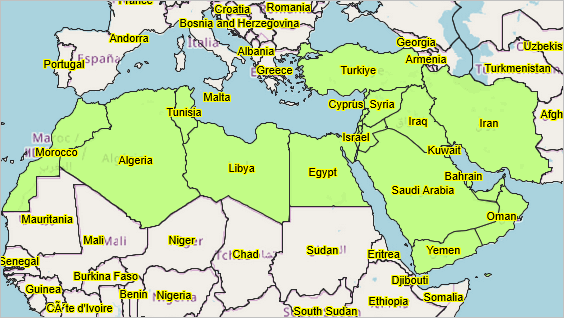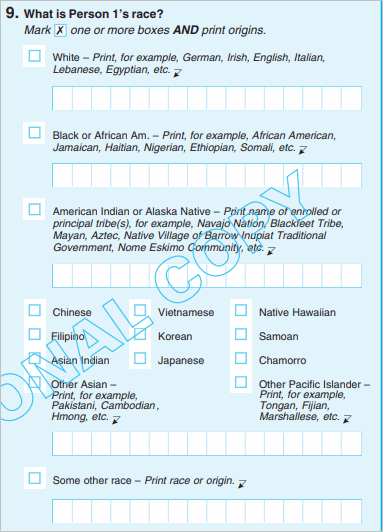

|
|
|
Middle Eastern and North African (MENA) Population Group -- MENA population characteristics and distribution across the U.S.
November 2023 .. Lebanese, Iranian and Egyptian populations represented nearly half of the 3.5 million who reported Middle Eastern and North African (MENA) descent in the 2020 Census — the first census to specifically solicit MENA responses. The MENA population classification is geographically based and includes Arabic-speaking groups, such as Egyptian and Jordanian, and non-Arabic speaking groups, such as Iranian and Israeli. It also includes ethnic and transnational groups from the region, such as Assyrian and Kurdish. Map View of the MENA Countries  The above graphic shows MENA countries with the green fill pattern. Create variations of the above map view using the using the VDA Desktop GIS tool and associated "us1_world1.gis GIS project. The 2020 Census form included a write-in response area to the White racial category, including German, Irish, English, Italian, Lebanese and Egyptian as examples. It is anticipated thet the race question will be further expanded for the 2030 census using more distinctive checkboxes rather than wrtie-in alone. The following graphic shows the entire 2020 Census race question.  MENA Race Classification Differs from Foreign Born Category The foreign-born population includes anyone who is not a U.S. citizen at birth, including those who have become U.S. citizens through naturalization. Citizenship is not a question asked on the 2020 Census form. Data on the foreign-born population is not available from 2020 Census but is available from the American Community Survey (ACS 2022). Census 2020 MENA Data Access Census 2020 MENA data, along with other non-MENA detailed race data, are in the DHC-A data release. These data are described in the associated DHC-A technical documentation (PDF). Accees MENA data using API calls with a browser. https://api.census.gov/data/2020/dec/ddhca?get=T01001_001N,NAME,POPGROUP_LABEL&POPGROUP=1071&for=tract:052519&in=state:06%20county:059 [["T01001_001N","NAME","POPGROUP_LABEL","POPGROUP","state","county","tract"], ["266","Census Tract 525.19; Orange County; California","Middle Eastern or North African alone","1071","06","059","052519"]] More Detail In 2020, over 3.5 million people identified as MENA alone or in any combination with another group, accounting for 1.5% of the White alone or in combination population. Within this population, over 2.5 million people (1.2% of the White alone population) identified as MENA alone. Together, Lebanese, Iranian and Egyptian, the three largest MENA groups, represented 46.9% (1,651,090 people) of the MENA alone or in any combination population.
The Lebanese population was the largest MENA alone or in any combination group with 685,672 people, accounting for nearly 20% of the MENA alone or in any combination population. The Lebanese population was also the second largest MENA alone group, with 328,137 people or 12.9% of the MENA alone population.
Iranian was the largest MENA alone group with 413,842 people and it was the second largest MENA alone or in any combination group (568,564 people), representing over 16% of the MENA alone and alone or in any combination populations in 2020. Egyptian was the third largest MENA group. Over 12% of the MENA alone population identified as Egyptian alone and 11.3% of the MENA alone or in any combination population identified as Egyptian alone or in any combination. The next largest MENA alone or in any combination groups were responses classified as “Other Middle Eastern and North African” (which refers to people who reported general terms such as “Middle East,” “North African,” as well as responses such as “Druze” and “Bedouin”), Arab (which refers to those who reported a response of “Arab” or “Arabic”), Syrian, Iraqi, Israeli, Palestinian, Moroccan and Jordanian, which all had populations of over 100,000. See more detail at about MENA population ProximityOne User Group Join the ProximityOne User Group to keep up-to-date with new developments relating to metros and component geography decision-making information resources. Receive updates and access to tools and resources available only to members. Use this form to join the User Group. Support Using these Resources Learn more about accessing and using demographic-economic data and related analytical tools. Join us in a Data Analytics Lab session. There is no fee for these one-hour Web sessions. Each informal session is focused on a specific topic. The open structure also provides for Q&A and discussion of application issues of interest to participants. Additional Information ProximityOne develops geodemographic-economic data and analytical tools and helps organizations knit together and use diverse data in a decision-making and analytical framework. We develop custom demographic/economic estimates and projections, develop geographic and geocoded address files, and assist with impact and geospatial analyses. Wide-ranging organizations use our tools (software, data, methodologies) to analyze their own data integrated with other data. Follow ProximityOne on Twitter at www.twitter.com/proximityone. Contact us (888-364-7656) with questions about data covered in this section or to discuss custom estimates, projections or analyses for your areas of interest. |
|
|